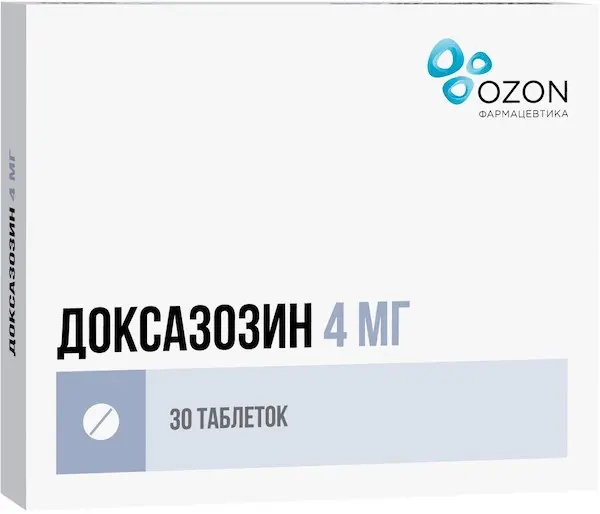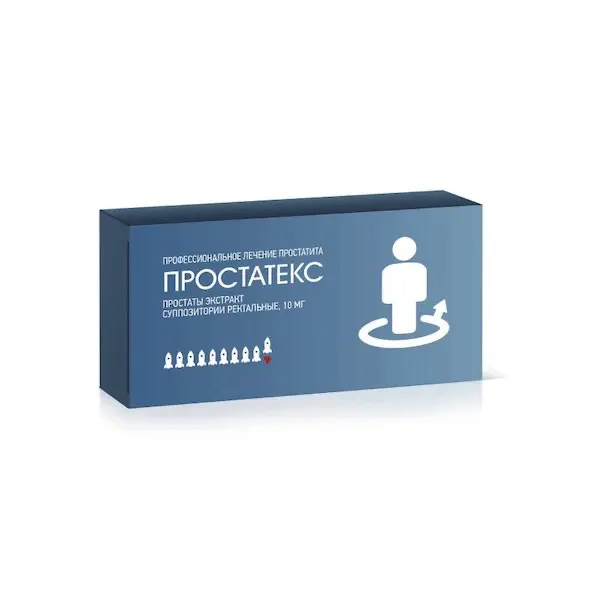Description
Doxazosin Pharmacodynamics
Benign prostatic hyperplasia
Administration of doxazosin to patients with symptoms of benign prostatic hyperplasia (BPH) results in significant improvement of urodynamic parameters and reduction of manifestations of the disease. This action of the drug is associated with selective blockade of α-adrenoreceptors located in the stroma and capsule of the prostate and the urinary bladder neck.
Doxazosin has been shown to be a blocker of α1-adrenoreceptors of subtype 1A, which represent approximately 70% of all α1-adrenoreceptor subtypes present in the prostate. This explains its effect in patients with BPH.
The maintenance effect of doxazosin treatment and its safety have been proven with long-term use of the drug (e.g., up to 48 months).
Arterial hypertension.
The use of doxazosin in patients with arterial hypertension leads to a significant reduction in blood pressure (BP) as a result of a decrease in total peripheral vascular resistance. The appearance of this effect is associated with selective blockade of alpha1-adrenoreceptors located in the vascular network. When administered once daily, clinically significant antihypertensive effect is maintained for 24 hours, BP decreases gradually; the maximum effect is usually observed 2-6 hours after oral administration. In patients with arterial hypertension BP during doxazosin treatment was similar in “lying” and “standing” positions.
It was noted that in contrast to non-selective alpha1-adrenoblockers, tolerance to the drug did not develop during long-term treatment with doxazosin. During maintenance therapy, increase of blood plasma renin activity and tachycardia are infrequent.
Doxazosin has a favorable effect on blood lipid profile, increasing the ratio of high density lipoproteins to total cholesterol and significantly reducing the concentration of total triglycerides and total cholesterol. In this regard, it has an advantage over diuretics and beta-adrenoblockers, which have no favorable effect on these parameters.
Taking into account the established connection of arterial hypertension and blood lipid profile with coronary heart disease, normalization of BP and lipid concentration against the background of doxazosin treatment leads to a decrease in the risk of coronary heart disease.
It was observed that doxazosin treatment resulted in regression of left ventricular hypertrophy, inhibition of platelet aggregation and increased activity of tissue plasminogen activator. In addition, doxazosin has been found to increase insulin sensitivity in patients with impaired glucose tolerance.
Doxazosin has no metabolic side effects and can be used in patients with bronchial asthma, diabetes, left ventricular failure and gout.
In vitro studies have shown antioxidant properties of 6′ and 7′-hydroxymetabolites of doxazosin at a concentration of 5 µmol.
In controlled clinical trials conducted in patients with arterial hypertension, treatment with doxazosin was accompanied by improvement of erectile function. In addition, in patients receiving doxazosin, recurrence of erectile dysfunction was less frequent than in patients receiving hypotensive agents.
Indications
– Benign prostatic hyperplasia: both in the presence of arterial hypertension and normal BP.
– Arterial hypertension: in combination with other hypotensive agents (thiazide diuretics, beta-adrenoblockers, “slow” calcium channel blockers or angiotensin-converting enzyme (ACE) inhibitors).
Contraindications
Hypersensitivity to doxazosin, other quinazoline derivatives (including prazosin, terazosin) or any of the excipients of the drug, other alpha-adrenoblockers; orthostatic hypotension (including history), chronic urinary tract infections, urolithiasis, anuria, concomitant urinary tract obstruction, progressive renal insufficiency; severe hepatic insufficiency (insufficient experience of use); breastfeeding period (when treating arterial hypertension), age less than 18 years (effectiveness and safety not established); lactose intolerance, lactase deficiency and glucose-galactose malabsorption syndrome.
Additionally, symptomatic therapy of BPH is indicated: urinary incontinence due to bladder overflow, arterial hypotension.
With caution:
Coronary heart disease or other heart diseases: pulmonary edema against aortic or mitral stenosis, heart failure with high cardiac output, right ventricular failure due to pulmonary embolism or exudative pericarditis, left ventricular failure with low ventricular filling pressure (see section “Special indications”).
Concomitant use with phosphodiesterase 5 (PDE-5) inhibitors, including sildenafil, tadalafil, vardenafil and udenafil.
Diabetic autonomic neuropathy, mild to moderate hepatic insufficiency; advanced age.
When performing surgery for cataract extraction.
Pregnancy and lactation:
Although doxazosin had no teratogenic effect in animal experiments, a decrease in fetal survival was observed when it was used at exceptionally high doses. Therefore, although no teratogenic or embryotoxic effects have been reported in experimental studies, doxazosin should only be administered in pregnancy if the benefit to the mother exceeds the potential risk to the fetus or newborn.
Animal studies have shown that doxazosin accumulates in the milk of lactating rats.
It is not known whether doxazosin is excreted with breast milk. Breast-feeding should be stopped if it is necessary to use doxazosin during lactation.
Dosage and administration
- Doxazosin can be administered both in the morning and in the evening and is intended for oral administration. It is taken once a day, regardless of meals. The tablet should be swallowed without chewing, with plenty of water.
- Benign prostatic hyperplasia
- The recommended starting dose of Doxazosin is 1 mg once daily, in order to minimize the possibility of orthostatic hypotension and/or fainting. Depending on individual urodynamic parameters and the presence of symptoms of BPH, the dose may be increased to 2 mg and then to 4 mg up to a maximum daily dose of 8 mg. The recommended interval for increasing the dose is 1-2 weeks. The usually recommended maintenance dose is 2-4 mg once daily.
- Arterial hypertension
- The dosage varies from 1 to 16 mg/day. Treatment is recommended to start with an initial dose of 1 mg once daily before bedtime. After the first dose, the patient should stay in bed for 6-8 hours. This is required due to the possibility of development of the “first dose” phenomenon, especially pronounced against the background of previous diuretics administration.
- If the therapeutic effect is insufficient, the daily dose may be increased to 2 mg after 1-2 weeks. Thereafter, every 1 to 2 weeks the dose may be increased by 2 mg. In the vast majority of patients, the optimal therapeutic effect is achieved at a dose of 8 mg per day. The maximum daily dose of 16 mg per day should not be exceeded. After achieving a stable therapeutic effect, the dose is usually withdrawn (the average therapeutic dose for maintenance therapy is usually 2-4 mg per day).
- If a diuretic or other hypotensive agent is added to the therapy, the dose of Doxazosin should be adjusted according to the patient’s condition with its further titration under medical supervision.
- In elderly patients and patients with impaired renal function, it is recommended to prescribe Doxazosin in usual doses.





